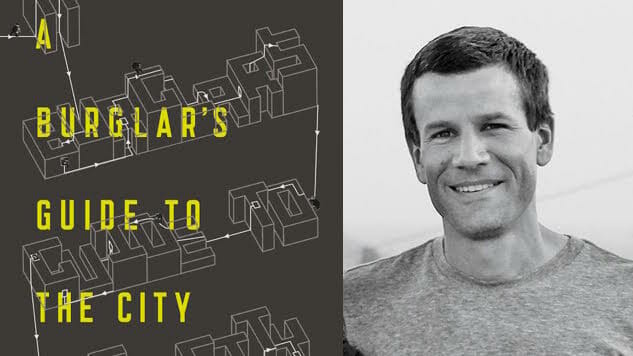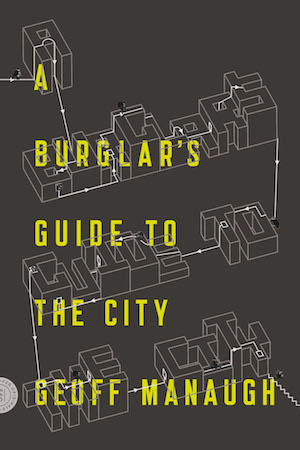Geoff Manaugh Explores Architecture’s Role in Crime in A Burglar’s Guide to the City
Author photo by Nicola Twilley Books Features
Burglary is unique among crimes in that it requires architecture for its execution. Human constructions are integral to its very definition, which involves the illicit entry of a structure with the intent to remove property. If there’s no structure, there’s no burglary—and you’re left with theft or robbery.
If burglary requires architecture, do burglars exhibit a predilection for architectural mores? When they cut holes in ceilings, tunnel into bank vaults, ignore well-guarded doors for the soft walls surrounding them, are burglars not demonstrating how an aberrant view of social and civil engineering can be brought to bear for personal enrichment?
In A Burglar’s Guide to the City, Geoff Manaugh, author of influential architecture site BLDGBLOG, explores the unique relationship between architecture, civic planning and crime. Paste chatted with Manaugh on the phone about custom-made crime, the unique spatial relationships of bandits and how Die Hard can best illustrate complex architectural concepts.
(Some questions have been edited for brevity.)
![]()
Paste: You talk in Burglar’s Guide about how burglary is a uniquely spatial crime. Why is that?
Manaugh: It’s true that it’s differently spatial from theft and larceny and that kind of thing. There are other spatial crimes, in the sense of trespassing, for example, but what’s so interesting to me about burglary is that it requires architecture to occur. I could commit a crime on the street, but unless I’m surrounded by four walls and a ceiling, I can’t be accused of burglary.
What I think is interesting about that is the construction of the built environment brought this new class of criminal activity, and it’s the flip side of architecture. It makes it this thing that sort of parasites itself onto the built environment in a way that I think is really interesting, legally speaking.
One of the things I talk about in the book is how, sheerly by dint of occurring within architecture, you get into these really complicated legal arguments about whether someone has committed burglary in the first place. So seemingly unrelated crimes—crimes that have nothing to do with theft, for example—can in fact be seen as burglary if they took place within a building. So if I go into a building without permission and commit a felony—if I were to fire an [unlicensed] handgun or any other kind of felonious activity—I could be accused of being a burglar.
Paste: Why do you think we, as a society, felt the need to define burglary as its own type of crime?
Manaugh: I think it says an awful lot about the importance that we place on private property, especially on the home. A burglary, in its common law origins, was only possible if something was a dwelling, and even then it was only possible if it was a dwelling at night. And so what that says is that when people are at home and at their most vulnerable, they need to be protected to a greater degree than at any other site in the city or at any other time of day. It says a lot that we look at the home as this kind of inviolable fortress that we have to protect at any cost.
Having said that, it is interesting to imagine a legal alternative where there is no such crime as burglary and where criminals can come and go inside and outside of houses and not be charged extra, or have their crimes seen as more severe. It would be interesting to reverse engineer from that the values of that society, insofar as where are the places in that society that they value the most. But I do think that says a lot about what we seek to protect more than other places.
 Paste: If burglary is an aberrant use of architecture, how are people using architecture to defend themselves? In the book, you mention panic rooms and capture houses, which are very elaborate. What are some ways that architecture can be used to protect what people want to keep protected?
Paste: If burglary is an aberrant use of architecture, how are people using architecture to defend themselves? In the book, you mention panic rooms and capture houses, which are very elaborate. What are some ways that architecture can be used to protect what people want to keep protected?
Manaugh: On one level, the sort of mundane, everyday level, it’s little things. You don’t want to have a side door or even a large back sliding door onto a porch hidden behind a privacy fence or shrubs. It’s great for you when you are home alone, or you’re having a party and want some privacy, but the exact same thing that you might construct, like a privacy fence, means that your neighbors can’t see a burglar. You’ve given them a disability, as well.
There’s also little things, like if a tree branch goes directly to a second floor window. If you’re a teenager, it’s a romantic way to sneak out of the house. From the point of view of home safety, it’s a really easy way for a burglar to just climb a tree and slip in through a window, which could even be left unlocked. It even extends down to what kind of glass you have in your windows. If you’ve got single-pane glass, it’s much less of a deterrent to a burglar to only have to break one pane of glass and get into your home as opposed to double-paned or even triple-paned storm glass, which is not only harder to break through, but produces so much glass debris and is so much louder that it can also be an effective deterrent.
All you really want to do is just delay them just enough that it doesn’t seem worth their time. If there’s a burglar coming to your neighborhood, and you can make your house look even just infinitesimally more protected than the one next to it, they probably are going to choose the one next to it.
Having said that, you can take this to quite extraordinary extremes. You can get all the way up to outright home fortification. That can include everything from bullet-proof windows, which are also resistant to hammer blows, to armor plating the walls of your house or, as you mentioned, installing panic rooms inside of a structure. It’s all kind of things. They really run the gamut.
Paste: You include pop culture illustrations throughout the book, including Die Hard, to help readers understand some of these concepts. Can you explain what “Nakatomi space” is?
Manaugh: One of the things that I really love about Die Hard is that it’s really easy to watch that movie only as a Hollywood blockbuster and as an action/adventure flick, and that’s fair enough. But the other way of watching that movie is it’s like the cinematic catalogue of all the ways in which architecture can be misused.
The entire plot of the film takes place in a skyscraper in Los Angeles that’s been seized by terrorists, and there’s one person who escapes the terrorist trap and runs wild through the building trying to thwart their plans. But he does so by going through walls, elevator shafts, air conditioning ducts, even shooting his way through doors rather than opening them. It’s all of these really unexpected and virtuoso ways of misusing architecture that constitutes the quote unquote plot of Die Hard.
Nakotomi space takes its name from the name of the building, which is called Nakatomi Plaza—it’s a fictional name—and I wanted to use Nakotomi space as an emblematic concept for what it means to use architecture less as something that other people have given you a plan for and more like a free, open topological space that you can use as you see fit. You can connect two rooms that weren’t connected before, you can connect two floors that had no other connection, you can suture parts of the building together. I think that there’s this topological approach that is part of burglary but is also really foregrounded in Die Hard.
Paste: Let’s jump from Die Hard to something like Heat and one of the most interesting concepts from the book: that cities get the crime they are designed for.
Manaugh: The example I use in the book is L.A. It’s the notion that when we make infrastructure decisions—we build freeways or subway tunnels or add a streetcar—we are also inadvertently opening up possible criminal opportunities that we just haven’t imagined yet. Someone is going to come along and realize that this streetcar line or this subway tunnel or the placement of this freeway opens up either a getaway route or a point of access for some other short circuit in the urban fabric that allows the crime to be committed.
In Los Angeles, it was the freeways leading to a spate of bank robberies. When they reached their peak in the 1990s, there was one bank robbery every 45 minutes of every workday, which is a mind-boggling number of bank robberies.
But there’s a fictional example I give in the book as well [Richard Stark’s The Score], where a burglary crew targets a town that only has one way in or out, only one police station, a fire station that can be commandeered and, if you basically take advantage of those vulnerabilities, the entire town can get robbed. It’s almost like the Moby Dick of burglary.
If you know your city is prone to being used in a certain way, then you have to fit that into your policing strategy.
Paste: We want to romanticize grand heists to a degree in pop culture, but a break-in that happened to your relatives threw that concept back into light for you. How important was it to not get swept away and realize burglary is not a victimless crime, even beyond the property that’s stolen?
Manaugh: I think it’s very important. It’s easy to romanticize the outlaw figure, or this Robin Hood-like idea of someone stealing from people who can afford it, or taking objects that are insured and getting away with it, in a George Clooney-like caper sense. It’s really easy to be seduced by that, in particular because burglars tend to be portrayed as, if not the hero, at the very least a sympathetic protagonist in pop culture.
Realizing that burglary actually has a very real psychological and emotional cost is important. If it’s just them stealing money from a bank, it’s easy to think, “Well, it’s insured by the FDIC, as long as no one was hurt during the heist, it’s really not a problem.” But even an office gets hit or a local bank, they lose the trust of their customers and have that psychological violation.
I definitely don’t look at my book as a handbook for committing future crime or some sort of celebration of the burglar figure. I think it’s important to remember that these are serious crimes with emotional consequences. It’s interesting nonetheless to watch how burglars use architecture, but that isn’t enough reason to treat them like folk heroes.